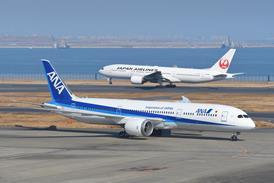Ramon Lopez/WASHINGTON DC
The US Federal Aviation Administration plans to suspend Alaska Airlines' authority to conduct heavy maintenance of its 89 aircraft after uncovering a number of problems with the US carrier's maintenance procedures and paperwork.
In April, Alaska was subjected to an intensive safety audit by FAA inspectors following the January crash of one of its Boeing MD-83s off California.
Crash investigators are focusing on maintenance of the MD-83's jackscrew assembly, which controls the horizontal stabiliser, and a grand jury is conducting a criminal probe of the airline's maintenance practices after accusations by mechanics.
FAA flight standards service director Nick Lacey says the extraordinary safety audit failed to find any unsafe aircraft. But the inspectors expressed "serious concerns" after uncovering maintenance lapses in documentation, record-keeping and quality assurance at the carrier's heavy maintenance centres in Oakland, California, and Seattle, Washington.
He says about 150 paperwork discrepancies, including undocumented maintenance work, were uncovered when 79 out of Alaska's 89 aircraft were inspected. Checks were made and no flight safety issues were revealed, but investigators found that maintenance procedures not endorsed by the FAA were being used. Repair of inoperative aircraft components were improperly deferred.
Alaska was given seven days to respond to the FAA's complaint and find a credible plan to correct its flawed heavy maintenance procedures. The maintenance work suspension would go into effect 30 days later and continue until the FAA was satisfied that Alaska is compliant.
Lacey also says the FAA will review Alaska Airlines' "ability to safely execute its growth plan."
The airline has 30 days to appeal the pending enforcement action.
Alaska's operations would suffer since it cannot contract out its heavy maintenance to get around a suspension as the FAA feels the carrier's monitoring of the work would be insufficient. Without the authority to perform major maintenance, Alaska would have to ground the five or six aircraft that normally go through heavy maintenance each month.
The situation would worsen should the suspension be protracted. Lacey says Alaska could lease aircraft to replace its grounded aircraft, but he believes it should not take the carrier long to solve the problems.
Lacey says FAA inspectors who regularly monitor Alaska Air should have known about the maintenance shortfalls. "We are just getting better in our oversight role. There are lessons to be learned on our part regarding training, awareness, and focus on certain critical areas."
John Kelly, Alaska's chairman and chief executive, believes that safety improvements already being implemented will show the FAA that the airline "can execute [maintenance] on a long-term basis."
Source: Flight International























